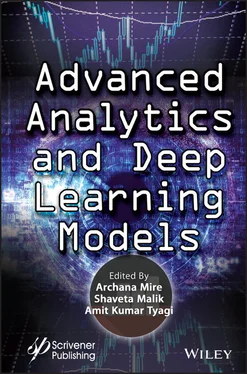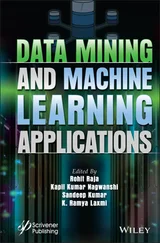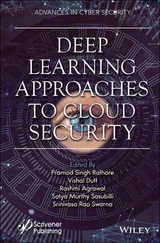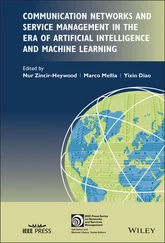Advanced Analytics and Deep Learning Models
Здесь есть возможность читать онлайн «Advanced Analytics and Deep Learning Models» — ознакомительный отрывок электронной книги совершенно бесплатно, а после прочтения отрывка купить полную версию. В некоторых случаях можно слушать аудио, скачать через торрент в формате fb2 и присутствует краткое содержание. Жанр: unrecognised, на английском языке. Описание произведения, (предисловие) а так же отзывы посетителей доступны на портале библиотеки ЛибКат.
- Название:Advanced Analytics and Deep Learning Models
- Автор:
- Жанр:
- Год:неизвестен
- ISBN:нет данных
- Рейтинг книги:5 / 5. Голосов: 1
-
Избранное:Добавить в избранное
- Отзывы:
-
Ваша оценка:
- 100
- 1
- 2
- 3
- 4
- 5
Advanced Analytics and Deep Learning Models: краткое содержание, описание и аннотация
Предлагаем к чтению аннотацию, описание, краткое содержание или предисловие (зависит от того, что написал сам автор книги «Advanced Analytics and Deep Learning Models»). Если вы не нашли необходимую информацию о книге — напишите в комментариях, мы постараемся отыскать её.
The book provides readers with an in-depth understanding of concepts and technologies related to the importance of analytics and deep learning in many useful real-world applications such as e-healthcare, transportation, agriculture, stock market, etc.
Audience
Advanced Analytics and Deep Learning Models — читать онлайн ознакомительный отрывок
Ниже представлен текст книги, разбитый по страницам. Система сохранения места последней прочитанной страницы, позволяет с удобством читать онлайн бесплатно книгу «Advanced Analytics and Deep Learning Models», без необходимости каждый раз заново искать на чём Вы остановились. Поставьте закладку, и сможете в любой момент перейти на страницу, на которой закончили чтение.
Интервал:
Закладка:
Table of Contents
1 Cover
2 Title Page
3 Copyright
4 Preface
5 Part 1: Introduction to Computer Vision 1 Artificial Intelligence in Language Learning: Practices and Prospects 1.1 Introduction 1.2 Evolution of CALL 1.3 Defining Artificial Intelligence 1.4 Historical Overview of AI in Education and Language Learning 1.5 Implication of Artificial Intelligence in Education 1.6 Artificial Intelligence Tools Enhance the Teaching and Learning Processes 1.7 Conclusion References 2 Real Estate Price Prediction Using Machine Learning Algorithms 2.1 Introduction 2.2 Literature Review 2.3 Proposed Work 2.4 Algorithms 2.5 Evaluation Metrics 2.6 Result of Prediction References 3 Multi-Criteria–Based Entertainment Recommender System Using Clustering Approach 3.1 Introduction 3.2 Work Related Multi-Criteria Recommender System 3.3 Working Principle 3.4 Comparison Among Different Methods 3.5 Advantages of Multi-Criteria Recommender System 3.6 Challenges of Multi-Criteria Recommender System 3.7 Conclusion References 4 Adoption of Machine/Deep Learning in Cloud With a Case Study on Discernment of Cervical Cancer 4.1 Introduction 4.2 Background Study 4.3 Overview of Machine Learning/Deep Learning 4.4 Connection Between Machine Learning/Deep Learning and Cloud Computing 4.5 Machine Learning/Deep Learning Algorithm 4.6 A Project Implementation on Discernment of Cervical Cancer by Using Machine/Deep Learning in Cloud 4.7 Applications 4.8 Advantages of Adoption of Cloud in Machine Learning/ Deep Learning 4.9 Conclusion References 5 Machine Learning and Internet of Things–Based Models for Healthcare Monitoring 5.1 Introduction 5.2 Literature Survey 5.3 Interpretable Machine Learning in Healthcare 5.4 Opportunities in Machine Learning for Healthcare 5.5 Why Combining IoT and ML? 5.6 Applications of Machine Learning in Medical and Pharma 5.7 Challenges and Future Research Direction 5.8 Conclusion References 6 Machine Learning–Based Disease Diagnosis and Prediction for E-Healthcare System 6.1 Introduction 6.2 Literature Survey 6.3 Machine Learning Applications in Biomedical Imaging 6.4 Brain Tumor Classification Using Machine Learning and IoT 6.5 Early Detection of Dementia Disease Using Machine Learning and IoT-Based Applications 6.6 IoT and Machine Learning-Based Diseases Prediction and Diagnosis System for EHRs 6.7 Machine Learning Applications for a Real-Time Monitoring of Arrhythmia Patients Using IoT 6.8 IoT and Machine Learning–Based System for Medical Data Mining 6.9 Conclusion and Future Works References
6 Part 2: Introduction to Deep Learning and its Models 7 Deep Learning Methods for Data Science 7.1 Introduction 7.2 Convolutional Neural Network 7.3 Recurrent Neural Network 7.4 Denoising Autoencoder 7.5 Recursive Neural Network (RCNN) 7.6 Deep Reinforcement Learning 7.7 Deep Belief Networks (DBNS) 7.8 Conclusion References 8 A Proposed LSTM-Based Neuromarketing Model for Consumer Emotional State Evaluation Using EEG 8.1 Introduction 8.2 Background and Motivation 8.3 Related Work 8.4 Methodology of Proposed System 8.5 Results and Discussions 8.6 Conclusion References 9 An Extensive Survey of Applications of Advanced Deep Learning Algorithms on Detection of Neurodegenerative Diseases and the Tackling Procedure in Their Treatment Protocol 9.1 Introduction 9.2 Story of Alzheimer’s Disease 9.3 Datasets 9.4 Story of Parkinson’s Disease 9.5 A Review on Learning Algorithms 9.6 A Review on Methodologies 9.7 Results and Discussion 9.8 Conclusion References 10 Emerging Innovations in the Near Future Using Deep Learning Techniques 10.1 Introduction 10.2 Related Work 10.3 Motivation 10.4 Future With Deep Learning/Emerging Innovations in Near Future With Deep Learning 10.5 Open Issues and Future Research Directions 10.6 Deep Learning: Opportunities and Challenges 10.7 Argument with Machine Learning and Other Available Techniques 10.8 Conclusion With Future Work Acknowledgement References 11 Optimization Techniques in Deep Learning Scenarios: An Empirical Comparison 11.1 Introduction 11.2 Optimization and Role of Optimizer in DL 11.3 Various Optimizers in DL Practitioner Scenario 11.4 Recent Optimizers in the Pipeline 11.5 Experiment and Results 11.6 Discussion and Conclusion References
7 Part 3: Introduction to Advanced Analytics 12 Big Data Platforms 12.1 Visualization in Big Data 12.2 Security in Big Data 12.3 Conclusion References 13 Smart City Governance Using Big Data Technologies 13.1 Objective 13.2 Introduction 13.3 Literature Survey 13.4 Smart Governance Status 13.5 Methodology and Implementation Approach 13.6 Outcome of the Smart Governance 13.7 Conclusion References 14 Big Data Analytics With Cloud, Fog, and Edge Computing 14.1 Introduction to Cloud, Fog, and Edge Computing 14.2 Evolution of Computing Terms and Its Related Works 14.3 Motivation 14.4 Importance of Cloud, Fog, and Edge Computing in Various Applications 14.5 Requirement and Importance of Analytics (General) in Cloud, Fog, and Edge Computing 14.6 Existing Tools for Making a Reliable Communication and Discussion of a Use Case (with Respect to Cloud, Fog, and Edge Computing) 14.7 Tools Available for Advanced Analytics (for Big Data Stored in Cloud, Fog, and Edge Computing Environment) 14.8 Importance of Big Data Analytics for Cyber-Security and Privacy for Cloud-IoT Systems 14.9 An Use Case with Real World Applications (with Respect to Big Data Analytics) Related to Cloud, Fog, and Edge Computing 14.10 Issues and Challenges Faced by Big Data Analytics (in Cloud, Fog, and Edge Computing Environments) 14.11 Opportunities for the Future in Cloud, Fog, and Edge Computing Environments (or Research Gaps) 14.12 Conclusion References 15 Big Data in Healthcare: Applications and Challenges 15.1 Introduction 15.2 Analytical Techniques for Big Data in Healthcare 15.3 Challenges 15.4 What is the Eventual Fate of Big Data in Healthcare Services? 15.5 Conclusion References 16 The Fog/Edge Computing: Challenges, Serious Concerns, and the Road Ahead 16.1 Introduction 16.2 Motivation 16.3 Background 16.4 Fog and Edge Computing–Based Applications 16.5 Machine Learning and Internet of Things–Based Cloud, Fog, and Edge Computing Applications 16.6 Threats Mitigated in Fog and Edge Computing–Based Applications 16.7 Critical Challenges and Serious Concerns Toward Fog/Edge Computing and Its Applications 16.8 Possible Countermeasures 16.9 Opportunities for 21st Century Toward Fog and Edge Computing 16.10 Conclusion References
8 Index
9 Wiley End User License Agreement
List of Table
1 Chapter 2 Table 2.1 Columns of dataset. Table 2.2 Different evaluation metrics. Table 2.3 Comparison of algorithm.
2 Chapter 3 Table 3.1 Dataset statistics. Table 3.2 Result comparison. Table 3.3 Dataset. Table 3.4 Comparison among clustering and non-clustering approach. Table 3.5 Comparison among existing methods in MCRS.
3 Chapter 4Table 4.1 Comparison of DL and ML.
4 Chapter 6Table 6.1 Literature review of existing technological works on Alzheimer’s disea...
5 Chapter 7Table 7.1 Model prediction accuracy.Table 7.2 Comparison between RCNN variants.Table 7.3 Comparison between Markov decision model and Q learning model.
6 Chapter 8Table 8.1 Percentage-wise usage of machine learning algorithms.
7 Chapter 9Table 9.1 Comparison on commonly utilized deep learning models [2].Table 9.2 Comparison of various algorithms on detection of AD.Table 9.3 Comparison of various algorithms on detection of Parkinson’s disease.Table 9.4 Results of the algorithm on detection of attacks on deep brain stimula...
8 Chapter 12Table 12.1 Comparison of 2018 vs. 2019 data security [1].Table 12.2 Data breach from February to June 2020 [1].
List of Figures
1 Chapter 1 Figure 1.1 Chatbot responding to the user contextually. Figure 1.2 Chatbot responding to the user contextually.
Читать дальшеИнтервал:
Закладка:
Похожие книги на «Advanced Analytics and Deep Learning Models»
Представляем Вашему вниманию похожие книги на «Advanced Analytics and Deep Learning Models» списком для выбора. Мы отобрали схожую по названию и смыслу литературу в надежде предоставить читателям больше вариантов отыскать новые, интересные, ещё непрочитанные произведения.
Обсуждение, отзывы о книге «Advanced Analytics and Deep Learning Models» и просто собственные мнения читателей. Оставьте ваши комментарии, напишите, что Вы думаете о произведении, его смысле или главных героях. Укажите что конкретно понравилось, а что нет, и почему Вы так считаете.












